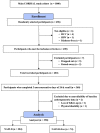Higher carbohydrate intake in relation to non-alcoholic fatty liver disease in patients with type 2 diabetes
- PMID: 36570126
- PMCID: PMC9773196
- DOI: 10.3389/fnut.2022.996004
Higher carbohydrate intake in relation to non-alcoholic fatty liver disease in patients with type 2 diabetes
Abstract
Background: Non-alcoholic fatty liver disease (NAFLD) is an overlooked complication of type 2 diabetes (T2D). Current recommendations for the management of NAFLD are mainly focused on weight reduction, overlooking the role of macronutrient composition. Although dietary carbohydrates play a major role in intrahepatic fat synthesis, their association with the progression of liver steatosis has not been fully investigated in patients with T2D.
Aim: To investigate the association between higher carbohydrate intake and the presence of liver steatosis in patients with T2D.
Methods: This cross-sectional study included men and women aged 18-60 years diagnosed with T2D. Anthropometric measurements, hepatic steatosis assessment using the controlled attenuation parameter (CAP), blood samples, and dietary data were analyzed. Participants were divided into two groups: NAFLD and NAFLD-free. A two-sample t-test was used to evaluate the differences between the two groups. Stepwise multiple linear regression models adjusted for potential confounders were used to determine the association between CAP values and higher carbohydrate intake.
Results: In total, 358 participants were included. NAFLD was present in 79.3% of the participants. Body mass index, waist circumference, ALT, HbA1c, and triglycerides showed direct, while HDL-Cholesterol revealed inverse associations with CAP values. No significant relationship was found between carbohydrate intake and steatosis in the total study sample; however, multiple linear regression analysis revealed a significant relationship between carbohydrate intake and CAP values in patients aged ≤50 years.
Conclusion: In patients with T2D, higher carbohydrate intake was associated with liver steatosis in those aged 50 years and below. Further studies are required to confirm the causality between carbohydrate intake and liver steatosis.
Keywords: carbohydrate; diet; non-alcoholic fatty liver disease; nutrition; type 2 diabetes.
Copyright © 2022 Alfadda, Aljuraiban, Awwad, Khaleel, Almaghamsi, Sherbeeni, Alqutub, Aldosary and Alfadda.
Conflict of interest statement
The authors declare that the research was conducted in the absence of any commercial or financial relationships that could be construed as a potential conflict of interest.
Figures
References
LinkOut - more resources
Full Text Sources
Miscellaneous


